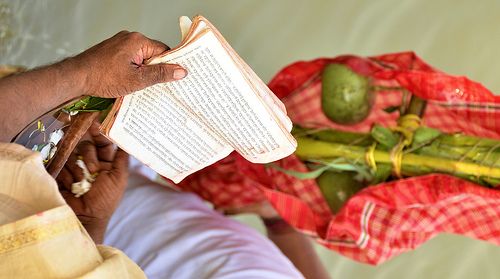The Nabapatrika Snan is a beautifully significant ritual that marks the beginning of the main festivities of Durga Puja, a grand celebration of the Divine Feminine, Goddess Durga, and the triumph of good over evil.
Significance of Maha Saptami
The ritual of Nabapatrika Snan is performed on the morning of Maha Saptami, the seventh day of Durga Puja (or Navratri). This day is considered immensely auspicious as it is when the Goddess is ceremonially invoked in the idol and begins her battle against the buffalo demon Mahishasura. Saptami is the first day of the Maha Puja (the main worship) when the deity’s presence is established, transforming the idol into a living manifestation of the Goddess.
Nabapatrika List
Nabapatrika, literally “Nine Leaves,” is a sacred bundle of nine different plants:
- Banana Plant (Kola): Goddess Brahmani
- Colocasia (Kachu): Goddess Kalika
- Turmeric (Haridra): Goddess Durga
- Jayanti: Goddess Kartiki
- Bel (Wood Apple) Leaves: Lord Shiva (Shivaa)
- Pomegranate (Darimba): Goddess Raktadantika
- Ashoka: Goddess Shokarahita
- Arum (Mankachu): Goddess Chamunda
- Rice Paddy (Dhan): Goddess Lakshmi
Nabapatrika Rituals
- The Bundle: These nine plants are tied together, often with a yellow thread, to the trunk of the banana plant.
- The Bath (Snan): Before sunrise, in the Brahma Muhurta, the Nabapatrika is carried in a procession to a river, pond, or other water body. Mantras are chanted as it is immersed and ritually purified—the ceremonial bath, or Snan.
- Adornment: After being bathed and smeared with vermillion, the Nabapatrika is wrapped in a new, traditional white sari with a red border.
- Installation: Reverently referred to as “Kolabou” (the Banana Bride), the Nabapatrika is brought back to the pandal and placed on the right side of Lord Ganesha, often considered his consort, signifying the unification of divine energies. The worship then proceeds with the Nabapatrika present alongside the main idol.
Nabapatrika Snan Symbolism & History
The ritual is a beautiful blend of ancient agrarian worship and later Hindu goddess devotion:
- Symbolism of Nine Forms (Nava Durga): Each of the nine plants symbolizes one of the nine forms of Goddess Durga (Navadurga) that are worshipped during Navratri, embodying the complete power of the Divine Mother.
- Agrarian Connection: The nine plants represent the forces of nature, fertility, and agricultural bounty. The ritual is a profound act of gratitude towards Mother Nature for sustaining life and reflects the festival’s deep-seated links to harvest and the cyclical rhythms of the earth.
- Invocation of Life (30Prana Pratishtha): The Nabapatrika acts as a ‘living medium’ or vessel in which the spirit of the Goddess is first invoked before being fully consecrated into the main Durga idol. This ritual is essential for initiating the primary worship.
Timing for Nabapatrika Snan in 2025
This year, Maha Saptami falls on Monday, September 29, 2025.
The Nabapatrika Snan Muhurta (auspicious time) is typically performed at dawn (before sunrise) on this day. The Dawn on Navpatrika Day is approximately 05:49 AM (specific time may vary slightly by location). The ritual is completed early in the morning before the day’s main prayers begin.
Experience the Divine!
Durga Puja is more than just a religious festival; it’s a magnificent cultural, artistic, and community celebration. The Nabapatrika Snan is a truly evocative, pre-dawn ritual that captures the festival’s deep spiritual and ecological roots.
We warmly encourage you to join the experience on Maha Saptami. Witness the solemn procession as the Nabapatrika is carried to the water, the chanting of the priests, and the moment it is adorned as the Kolabou. It is an unforgettable opportunity to connect with an ancient tradition, honor the Divine Mother in all her natural forms, and truly feel the vibrant spirit of Durga Puja!
Feature Image Credit: Pinterest.
